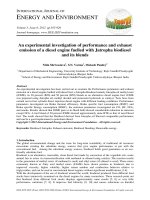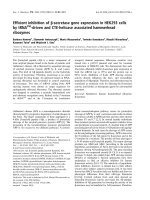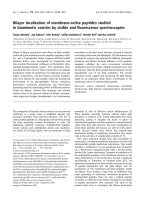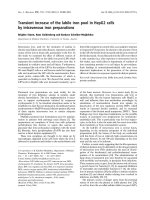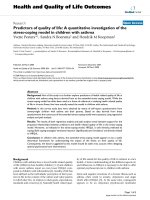Investigation of chlorophyll and beta carotenoids in edible oils by absorption and fluorescence spectroscopy
Bạn đang xem bản rút gọn của tài liệu. Xem và tải ngay bản đầy đủ của tài liệu tại đây (1.68 MB, 58 trang )
INVESTIGATION OF CHLOROPHYLL AND BETA CAROTENOIDS IN
EDIBLE OILS BY ABSORPTION AND FLUORESCENCE SPECTROSCOPY
By
Tewodros Taye Assefa
A THESIS SUBMITTED TO
THE DEPARTMENT OF PHYSICS
PRESENTED IN PARTIAL FULFILLMENT OF THE REQUIREMENTS FOR
THE DEGREE OF MASTER OF SCIENCE IN PHYSICS
ADDIS ABABA UNIVERSITY
ADDIS ABABA, ETHIOPIA
JUNE 2017
© Copy right by Tewodros Taye Aassefa, 2017
Declaration
I, Tewodros Taye Assefa, declare that this thesis is my own work and all sources or materials
used for this thesis have been duly acknowledged. This thesis is submitted to the department of
physics in Partial Fulfillment of the Requirements for the awarded Degree of Master of Science.
Signed by the Examination committee:
Advisor: Name:
Signature: ____________ Date: ___________________
Examiner: Name:
Signature: _______________Date: ___________________
Examiner: Name:
Signature: _______________Date: ___________________
June, 2017
Addis Ababa – Ethiopia
Table of content……………………………………………………………… page
Acknowledgement ........................................................................................................................... i
Abstract ........................................................................................................................................... ii
List of figures................................................................................................................................. iii
List of Table……………………………………………………………………………………… 1
1. Introduction................................................................................................................................. 1
1.1 Background............................................................................................................................ 1
1.1.1 Chlorophyll Benefits........................................................................................................... 3
1.1.2 Carotenoids Properties and Functions ................................................................................ 4
1.1.3
-Carotene ........................................................................................................................ 5
1.1.4 Beta-carotene Benefits ........................................................................................................ 6
1.2 Objective of the study............................................................................................................ 7
1. 2 .1 General objective .............................................................................................................. 7
1. 2 .2 Specific objectives ............................................................................................................ 7
1.3 Literature review.................................................................................................................... 7
1.3.1 Optical properties of chlorophyll and beta-Carotenoids of edible oils ............................... 7
1.4 Theoretical Background of the instruments......................................................................... 14
1.4.1 Absorption Spectroscopy .................................................................................................. 14
1.4.1.1 Absorbance and the Beer – Lambert Law............................................................... 15
1.4.2 Fluorescence Spectroscopy............................................................................................... 17
1.4.3 Excitation and Emission Spectra ...................................................................................... 19
1.4.3.1 Excitation Spectrum................................................................................................ 19
1.4.3.2 Emission Spectrum ................................................................................................. 19
1.4.4 Stokes Shift ....................................................................................................................... 20
2. Material and methods................................................................................................................ 21
2.1 Materials ............................................................................................................................ 21
2.1.1 Oils…...………………………………………………………………………………….21
2.2 Instruments .......................................................................................................................... 22
2.2.1 Absorption spectra measurements .................................................................................... 22
2.2.2 Fluorescence spectra measurements ................................................................................. 22
2.3 Sample preparation .............................................................................................................. 22
2.4 Data Collection and Spectral Data Analysis........................................................................ 23
2.5 Experimental set up of the instruments ............................................................................. 24
3.Results and discussion ............................................................................................................... 25
3.1 Absorption and fluorescence Spectra ................................................................................. 25
3.1.1 Chlorophyll and beta-Carotenoid from extra virgin olive oil (Spain) .............................. 25
3.1.2 Chlorophyll and beta carotenoid from extra virgin olive oil (Italy)……………………..28
3.1.3 Chlorophyll and beta-carotenoid from Niger seed oil (Ethiopia) ..................................... 30
3.1.4 Chlorophyll and beta-carotenoid from olive oil (Spain) .................................................. 32
3.1.5 Chlorophyll and Beta-carotenoid from olive pomace oil (Italy) ...................................... 34
3.1.6 Chlorophyll and beta-carotenoid from composition of refined olive oil and virgin olive
oil (Italy) .................................................................................................................................... 35
3.1.7 Chlorophyll and beta-carotenoid from sunflower oil (Ethiopia) ...................................... 37
3.1.8 Chlorophyll and beta-carotenoid from soya bean oil (turkey) ......................................... 38
3.9 Wavelengths of edible oils corresponding to their Absorbance maximum........................... 39
3.10 Fluorescence Spectra of chlorophyll a and fatty acid composition in edible Oils ............ 42
4.
Conclusion .......................................................................................................................... 45
5.
References........................................................................................................................... 47
Acknowledgement
Above all I thanks God; nothing can be done without his will. Behind the realization of this
thesis there are some wonderful people who must be mentioned and acknowledged, without them
it would have been very challenging.
I want to forward a special recognition to my organization Federal Police Commission in general
and Federal Police Crime Investigation Bureau in particular for giving me this opportunity.
I want to express my gratitude to my advisor A.V Gholap (Professor) for his support
encouragements and guidance throughout this thesis work.
I express heartfelt appreciation to Mr.Tesfaye Mamo (chief technical assistance) for his great
contribution and dedication, Yet again many thanks for inspiring me to do throughout this thesis
work.
i
Abstract
The absorption spectra of olive oil(Spain), extra virgin olive oil(Spain), extra virgin olive
oil(Italy) , olive
oil composed of refined olive oil and virgin olive oil(Italy), soya bean
oil(turkey) , sunflower oil(Ethiopia), Niger seed oils (Ethiopia), were studied along with the
relative peaks of chlorophyll a, chlorophyll b and beta-Carotenoids in each of the eight types of
edible oils. The oil was diluted by n-hexane (1% v/v) in a 10 mm quartz cuvette and the
absorption spectrum of chlorophyll a, chlorophyll b and beta-Carotenoids was determined over
a range of 400-750 nm. The relative peaks in the blue region 410nm-414nm of chlorophyll a and
in the red region chlorophyll a peaks appear from 660nm-671nm, chlorophyll b peaks appear in
the blue region from 440nm-455nm and beta-Carotenoids peaks from 470nm-483nm were
determined by using the given sample of edible oils based on the absorbance data.
The
absorbance spectrum of most of the edible oils in the visible light range of chlorophyll and betacarotene gives interesting results. The fluorescence spectrum of chlorophyll a and fatty acid
composition of eight edible oil samples were obtained the emission spectra in the range from
420 to 750 nm, at excitation wavelengths from 350 to 420 nm, with a wavelength
difference(steps) of 10nm, 15nm and 20nm. There are two spectral regions in which
Fluorescence spectra of edible oils are observed: The first one is a base width in the interval
640-750 nm and a top width 650–675nm with a maximum at 671 nm occurs for chlorophyll a.
The second one is a broad peak with a base width of in the interval 420-630 nm and a top width
of 450–470 nm. With a maximum at 466 nm, is due to the products of per oxidation
(degradation) of polyunsaturated fatty acids in the oil.
Key words: Edible oils, absorbance spectroscopy, fluorescence spectroscopy, chlorophyll
and beta- carotenoids
ii
List of figures
Figure 1.1 molecular structure of chlorophyll a ......................................................................... 2
Figure 1.2 molecular structure of chlorophyll b ......................................................................... 2
Figure1. 6 Structure of beta- carotenoid ..................................................................................... 5
Figure 1.7 absorbance and beer Lambert law........................................................................... 15
Figure 1.8 Jablonski diagram……………………………………….……………………………………………..17
Figure.1.9: Excitation and emission spectra of a fluorophore. The emission spectra are plotted
for excitation at three different wavelengths (EX1, EX2, and EX3). ......................................... 19
Figure 1.10 Stokes shift difference between the excitation and emission spectrum. ............... 20
Figure 2.1 Experimental set up of absorption spectroscopy..................................................... 24
Figure 2.2 Experimental set up of fluorescence spectroscopy ................................................. 24
Figure 3.1 absorption spectrum of chlorophyll and beta-carotene from extra virgin olive oil
(Spain)................................................................................................................................26
Figure.3.2 fluorescence Spectrum of Chlorophyll a from extra virgin olive oil (Spain) ......... 27
Figure 3.3 absorbance of chlorophyll and beta–carotenoid of extra virgin olive oil (Italy). ... 28
Figure 3.4 chlorophyll a fluorescence spectra of extra virgin olive oil (Italy) ......................... 29
Figure 3.5 Absorption Spectrum of Chlorophyll and beta-carotenoid Niger seed oil.............. 30
Figure 3.6 fluorescence spectrum of chlorophyll a of Niger seed oil....................................... 31
Figure 3.7 Absorption Spectrum of Chlorophyll and beta-carotenoid from olive oil .............. 32
Figure 3.8 chlorophyll a fluorescence of olive oil (Italy)......................................................... 33
Figure 3.9 Absorption Spectrum of Chlorophyll and beta-carotenoid from olive pomace oil. 34
Figure 3.10 chlorophyll a fluorescence spectra of olive pomace oil ........................................ 35
Figure 3.11 Absorption Spectrum of Chlorophyll and beta carotenoid from composition of
Refined olive oil and virgin olive oil……………………………………… 35
Figure 3.12 chlorophyll a fluorescence spectra of composition of refined olive oil and virgin
Olive oil……………………………………………………………………… 36
Figure 3.13 Absorption Spectrum of Chlorophyll and beta- carotenoid from sunflower oil ... 37
Figure 3.14 fluorescence of chlorophyll a of sunflower oil…………………………………....37
Figure 3.15 Absorption Spectrum of Chlorophyll and beta carotene from soya bean oil ........ 38
Figure 3.16 shows that the fluorescence of soya bean oil ........................................................ 39
Figure 3.17 shows wave length maxima from extra virgin olive oil and Niger seed oil…....40
Figure 3.18 wavelength maxima of extra virgin olive oil (Italy), olive oil (Spain), composition
Of refined and virgin olive oil (Italy) and olive pomace oil…………………
41
Figure 3.19 wavelength maxima of sunflower (Ethiopia) and soybean oil (turkey) ................ 41
iii
Figure 3.20 Fluorescence of the eight edible oils ..................................................................... 43
List of table
Table 3.1 Wavelengths of edible oils corresponding to their Absorbance maxima ................. 42
iv
1. Introduction
1.1 Background
Chlorophyll is any of several closely related green pigments found in cyanobacteria and
the chloroplasts of algae and plants. Chlorophyll is essential in photosynthesis, allowing plants
to absorb energy from light. Chlorophyll absorbs light most strongly in the blue portion of
the electromagnetic spectrum, followed by the red portion. Conversely, it is a poor absorber of
green and near-green portions of the spectrum, which it reflects, producing the green color of
chlorophyll-containing tissues. Chlorophyll was first isolated and named by Joseph Bienaimé
Caventou and Pierre JosephPelletier in1817 (Speer, Brian R. 1997).
Molecules that are good absorbers of light in the visible range are called pigments. Organisms
have evolved a variety of different pigments, but there are only two general types used in green
plant photosynthesis: Carotenoids and chlorophylls. There are two kinds of chlorophyll in plants,
chlorophyll a and chlorophyll b, which preferentially absorb blue and red light. Chlorophylls
absorb photons within narrow energy ranges. Neither of these pigments absorbs photons with
wavelengths between 500 - 600 nm, and light of these wavelengths is, therefore, reflected by
plants. When these photons are subsequently absorbed by the pigment in our eyes, we perceive
them as green. Chlorophyll a is the main photosynthetic pigment and is the only pigment that can
act directly convert light energy to chemical energy. However, chlorophyll b, acting as an
accessory or secondary light-absorbing pigment, complements and adds to the light absorption of
chlorophyll a. Chlorophyll b has an absorption spectrum shifted toward the green wavelengths.
Therefore, chlorophyll b can absorb photons that chlorophyll a cannot. Chlorophyll b therefore
greatly increases the proportion of the photons in sunlight that plants can harvest. An important
group of accessory pigments, the Carotenoids, assists in photosynthesis by capturing energy from
light of wavelengths that are not efficiently absorbed by either chlorophyll (C. B. van Niel,
1930).
The absorption of light by different pigments causes excitation of electrons from their
ground state to an excited state. Light absorption takes place at the reaction centers of photo
systems that contain accessory and primary pigments (Gross, Jeana, 1991).
1
All green plants contain chlorophyll a and chlorophyll b in their chloroplasts.
Chlorophyll b differs from chlorophyll a by having an aldehyde (-CHO) group in place of a
methyl group
(-CH3) as shown the figure 1.1 & 1.2 below. This aldehyde group is also the
reason that chlorophyll b has a greater molecular weight than chlorophyll a.
Along with
chlorophylls, the chloroplast also contains a family of accessory pigments called Carotenoids
(Campbell, N.A 1996). In higher plants, chlorophyll a is the major pigment and chlorophyll b is
an accessory pigment.
The structural formula of Chlorophyll a is C55H72O5N4Mg with a molecular weight of 893.48
g/mol and Chlorophyll b has a structural formula of C55H70O6N4Mg and a molecular weight of
907.46 g/mol (Paech K. and M.V. Tracey 1955). The differences in these structures cause the
red absorption maximum of chlorophyll b to increase and lower its absorption coefficient
(Goodwin, T.W 1965). Chlorophyll pigments strongly absorb in the red and blue regions of the
visible spectrum, which accounts for their green color.
Figure 1.1 molecular structure of chlorophyll a
Figure 1.2 molecular structure of chlorophyll b
2
During storage, chlorophyll encounters many elements, which cause degradation.
Chlorophyll a is formed about five times faster than chlorophyll b. Chlorophyll is present in the
seed being part of the chloroplasts present in the cotyledons. While the amount of chlorophyll in
seeds decreases during maturation, significant amounts are often left, especially in areas where
the seed is maturing and being harvested into a cool fall or winter season. The problem is most
prominent in B. napus L. summer sown seed types but may occur in other species and types
occasionally (James K. Daun 2012).
Carotenoids are organic pigments that are produced by plants and algae, as well as several
bacteria and fungi. Carotenoids can be produced from fats and other basic organic metabolic
building blocks by all these organisms. Carotenoids from the diet are stored in the fatty tissues of
animals, and exclusively carnivorous animals obtain the compounds from animal fat (Boran
Altincicek 2011) .There are over 700 known Carotenoids; they are splits into two classes,
xanthophylls (which contain oxygen) and
carotenes (which are purely hydrocarbons, and
contain no oxygen). All are derivatives of tetraterpenes, meaning that they are produced from
8 isoprene molecules and contain 40 carbon atoms. In general, Carotenoids absorb wavelengths
ranging from 400-520 nanometers (violet to green light) in the visible spectrum. This causes the
compounds to be deeply colored yellow, orange, or red (Armstrong GA, Hearst JE 1996).
Carotenoids serve two key roles in plants and algae: they absorb light energy for use in
photosynthesis, and they protect chlorophyll from photo damage. Carotenoids that contain
unsubstitude beta-ionone rings (including beta-carotene, carotene, beta-cryptoxanthin and gammacarotene) have vitamin A activity (meaning that they can be converted to retinol), and these and
other Carotenoids can also act as antioxidants. In the eye, certain other Carotenoids
(lutein, astaxanthin, and zeaxanthin) apparently act directly to absorb damaging blue and nearultraviolet light, in order to protect the macula of the retina, the part of the eye with the sharpest
vision.( Armstrong GA, Hearst JE 1996).
1.1.1 Chlorophyll Benefits
Several research results have demonstrated that plant pigments play important roles in health. It
has been reported that chlorophyll concentrations encountered in chlorophyll-rich green
3
vegetables can provide substantial cancer chemo protection, and suggested that they do so by
reducing carcinogen bioavailability (Chipmunka, 2008).
Chlorophyll benefits include helping fight cancer, improving liver detoxification, speeding up
wound healing, improving digestion and weight control, and protecting skin health. (Sudakin DL
2003).
Chlorophyll is a super food because of its strong antioxidant and anticancer effects.
Chlorophyll benefits the immune system because it’s able to form tight molecular bonds with
certain chemicals that contribute to oxidative damage and diseases like cancer or liver disease
(Kidd, Parris 2011).
The very best sources of chlorophyll are found on the planet are green vegetables and algae.
Here are some of the top food sources to incorporate into your diet to experience all of the
chlorophyll benefits. This includes dark green leafy veggies like kale, spinach and Swiss chard.
Cooking these foods decreases the nutrient content and lowers the chlorophyll benefits, so eat
them raw or lightly cooked to preserve the nutrients (Kidd, Parris 2011, Boran Altincicek 2011,
Sudakin DL 2003).
1.1.2 Carotenoids Properties and Functions
Due to the coloring properties of Carotenoids, they are often used in food, pharmaceutical and
cosmetics. In addition to their extensive use as colorants, they are also used in food fortification
because of their possible activity as provitamin A and their biological functions to health benefit,
such as strengthening the immune system, reducing the risk of degenerative diseases, antioxidant
properties and anti obesity/hypolipidemic activities. (N. Mezzomo, L. Tenfen and M. S. Farias
2015).
From the non enzymatic compounds, on antioxidant defense, some minerals (copper,
manganese, zinc, selenium and iron), vitamins (ascorbic acid, vitamin E, and vitamin A),
carotenoids ( -carotene, lycopene, and lutein), bioflavonoids (genistein, quercetin), and tannins
(catechins) can be detached .
4
1.1.3
-Carotene
Figure1. 6 Structure of beta- carotenoid
-Carotene is an organic, strongly colored red-orange pigment abundant in plants and
fruits. It is a member of the carotenes, which are terpenoids (isoprenoids), synthesized
biochemically from eight isoprene units and thus having 40 carbons. Among the carotenes, βcarotene is distinguished by having beta-rings at both ends of the molecule, β-Carotene is the
most common form of carotene in plants. When used as a food coloring (Susan D. Van Arnum
1998).
Among the Carotenoids, the -carotene is the most abundant in foods that has the highest
active pro vitamin A. It is found in some varieties of pumpkin, carrot, nuts, carrot noodles rose
hip fruits and palm oil, extra virgin olive oil, olive oil, which is an excellent source due to being
free from any barrier of vegetal matrix and thus has increased bioavailability of this pigment
“beta-carotene” (G. Britton S, volume 5, 2009).
In the uv visible, spectroscopy for β-Carotene shows the absorption for this compound to
be strongest from 400-500 nm, which lies in the green/blue part of the electromagnetic spectrum.
Hence, precisely due to the absorbance at the green/blue range, the red/yellow colors of visible
light are reflected back and carrots appear orange. As the position of blue-green, the color
absorbed by these pigments, is exactly complementary to red-orange, the color that is reflected
(H., Keiler M. 2011).
5
1.1.4 Beta-carotene Benefits
Beta-carotene is the main safe dietary source of vitamin A, essential for normal growth and
development, immune system function, and vision (G. Britton S.2009).
Beta-carotene and other Carotenoids can facilitate communication between neighboring cells by
stimulating the synthesis of proteins that form pores in cell membranes, allowing communication
through the exchange of small molecules. This effect appears unrelated to the vitamin A or
antioxidant activities of various Carotenoids.
Beta-carotene is thought to possess many positive health benefits and in particular helps prevent
night blindness and other eye problems.
It also effective in skin disorders, enhances immunity, protects against toxins and cancer
formations, colds, flu, and infections. It is an antioxidant and protector of the cells while slowing
the aging process.
It is considered that natural Beta-Carotene aids in cancer prevention. It is important in the
formation of bones and teeth. No vitamin overdose can occur with natural Beta-Carotene. (Van
Poppel G. 1993, Hughes DA. 1997, Bertram JS. 1999).
In view of above the beneficial effects of chlorophyll and beta-Carotenoids it’s of interest to
study these compounds in edible oils which are used for daily consumption.
6
1.2 Objective of the Study
1. 2 .1 General Objective
The overall objective of the study is to investigate Chlorophyll a, Chlorophyll b and betaCarotene found in edible oil by using absorption and fluorescence spectroscopy through
quantitative determination.
1. 2 .2 Specific objectives
The study enfolds the following specific objectives: To determine an absorption spectrum of Chlorophyll a , Chlorophyll b and beta-carotene in
the visible range of wavelengths of light absorbed by the molecules
To determine chlorophyll a and fatty acid by fluorescence spectroscopy in the edible oils
To compare the performance of absorbance and fluorescence spectroscopy in differentiating
the composition of Chlorophyll a found in edible oils
1.3 Literature review
1.3.1 Optical properties of chlorophyll and beta-Carotenoids of edible oils
Fats and oils constitute one of the major categories of food products, as they contain
many nutrients. The great interest in studying the chemical composition of oils since such
information is valuable for the assessment of oil quality. Apart from the major components, trifatty acid esters of glycerol, vegetable oils contain about 2–5% of minor compounds in a wide
range of chemical classes. These compounds have a marked influence on the oil quality. For
instance, tocopherols and carotenoids affect the oxidative stability of oils, whereas chlorophylls
are responsible for oil photo oxidation (De Man, J. M. 1999).
Edible oils (olive oil, seed oil) have interesting optical properties (absorption and
fluorescence) due to the content of optically active compounds, such as chlorophyll, betacarotene and others. These properties can be used to recognize and characterize the various types
of oil. In the spectrum of “Extra Virgin” olive oil, obtained by cold pressing you notice the
absence of the products of per oxidation of fatty acids, which give fluorescence at about 470nm.
This happens both because the oil is cold worked and because the high content of natural anti-
7
oxidants (carotenes and poly phenols) prevents oil from oxidative degradation. Seed oils show all
components to varying degrees, a clear fluorescence at about 470nm, a sign of the content in
peroxides resulting from oxidative degradation of fatty acids, both because they are supposedly
hot worked and because of the lower content of molecules anti-oxidants. Olive oil absorption
spectrum has absorption maxima in the red band at around 660-670nm and in the blue band, less
than 500nm, Olive oil absorption is due to Carotenoids and chlorophylls (physicsopenlab.org ›
English Posts 2015).
Sunflower oil fluorescence spectrum excited by uv-visible emission at 405nm.The
fluorescence band with peaks at 464nm and 476nm are presumably due to the products of per
oxidation (degradation ) of polyunsaturated fatty acids in the oil (oleic and linoleic)(
physicsopenlab.org › English Posts 2015).
The weak fluorescence peak around 666 nm for the sunflower oil is caused by the
presence of chlorophyll-a. No such peaks were discovered in soybean oil since they do not
contain or contain very little chlorophyll-a (Krastena Nikolova 2012).
Carotenoids, present in olive oil with a relatively high concentration, are characterized by
a less intense emission. In fact, carotenoids strongly compete for incident light with other
chromophores present in olive oil due to their concentration and high extinction coefficient.
Carotenoids signals can be observed in the 430–480 nm regions, but their quantification remains
very difficult by fluorescence techniques (Maurizio Zandomeneghi 2005).
Soybean oil fluorescence spectrum excited by UV-vis emission at 405nm,The
fluorescence band with the peak at 477nm is presumably due to the products of per oxidation
(degradation ) of polyunsaturated fatty acids present in the oil (oleic and linoleic) . The same
applies to the band with a peak at 533nm, to assess the contribution of vitamin E on the
emissions of the green fluorescence (physicsopenlab.org › English Posts 2015).
For some oils, namely linseed (seed oils) and olive oil, a long-wavelength band is observed
with excitation at about 350 nm–420 nm and emission at about 660 nm–700 nm. This band was
attributed to pigments of chlorophyll group, based on its excitation and emission characteristics.
This group includes chlorophylls a and b, and pheophytins a and b, derived from chlorophylls by
loss of magnesium (B. Schoefs 2003).
Visible absorption spectra of extra-virgin olive oils have characteristic features .a three
peak band in the range 390–520 nm and a sharper band around 660–675 nm. This last absorption
8
band is due to the electronic transition of chlorophylls and their derivatives, while the first band
is more complex, since it is due to the overlap among Carotenoids and chlorophylls absorption
signals. In the visible absorption spectrum of extra-virgin olive oils is very different from the
absorption spectra of other seeds and fruits oils. This evidence is at the basis of several works
devoted to the authentication of extra virgin olive oils and the identification of specific frauds,
such as the mixing between olive oils and oils obtained from other seeds. Visible (vis) light
absorption of extra virgin olive oils is associated with the pigments’ content, and this specificity
is at the origin of several research works aiming to substitute the chromatographic methods with
much faster and direct spectrophotometry methods (Cayuela J.A., ousf K., Martinez M.C 20014,
Torrecilla J.S., Rojo E 2010).
The colour of olive oil related to its pigment content varies from a light gold to a rich
green. Green olives produce green oil because of the high chlorophyll content, while ripe olives
yield yellow oil because of the carotenoids (yellow red). The exact combination and proportions
of pigments determine the final colour of the oil. Their presence in olive oil depends on olive
fruits (Olea europa, L.), but also on genetic factors (olive cultivar), the stage of fruit ripeness,
environmental conditions, the extraction processing and storage conditions. The role of
chlorophylls as natural pigments accounting for greenish colours and in photosynthesis is well
known. There are also some reports about the benefits of dietary chlorophylls for human health
(Gandul‐Rojas B.2000, Giuliani A. 2011).
The structure of chlorophyll pigments, consisting of one tetrapyrrole macro cycle,
coordinated to Mg2+ ion to form a planar complex, is responsible for the absorption in the visible
region of the spectrum of olive oils. Here, both the bluish‐green chlorophyll‐a and the
yellowish‐green chlorophyll‐b can be found. Chlorophylls in olive oils are mostly converted to
pheophytins, due to the exchange of the central Mg2+ ion with acid protons. Pheophytin‐a is
100% Products from Olive Tree predominant with respect to Pheophytin‐b. In the case of bad
storage conditions, Pheophytin are further degraded to pyropheophytins .The main carotenoids
present in olive oils are lutein and β‐carotene (Cristina Lazzerini, 2016).
Fluorescence
spectroscopy can be more diagnostically helpful due to the selective excitation of pigments, such
as chlorophylls, but useless in case of carotenoids, since their fluorescence is very weak ( Sayago,
A.2004).
9
A useful technique to study chlorophylls and Carotenoids is fluorescence spectroscopy
which is a photoluminescence process. Fluorescence spectroscopy can be performed by right
angle with several possibilities of investigation. Different types of signals can be indeed
acquired: emission spectra, excitation spectra. Several works have been published based on
fluorescence spectroscopy applied to extra virgin olive oils .since several chemical constituents,
including pigments, give fluorescence in specific conditions and they can be identified. The
quantification of fluorophores is less straightforward than in absorption spectroscopies. In
particular, this work shows that the right angle method gives several artifacts, while front face
technique is more appropriate for quantification of fluorophores. In emission spectra of olive
oils, the band centered at 670–680 nm is clearly due to chlorophyll like chromophores
(Zandomeneghi M. 2005). The fluorescence excitation-emission (λex=300-390 nm and
λem=415-600 nm) were used in studies of the Spanish extra virgin, virgin, pure, and olive
pomace oils, to investigate the relationship between oil fluorescence and the conventional quality
parameters, including peroxide value (Guimet F.2005c).
Total synchronous fluorescence spectra measured emission peaks between 500-700 nm,
depending on
for both classes of oils. Classification of virgin olive oils based on their
synchronous fluorescence spectra was performed by hierarchical cluster analysis and partial least
squares using the 429–545 nm spectral range. The authors conclude that the fluorescence in the
429–545 nm range, which they used for data analysis, originates from oleic acid (Poulli K.
2005).
The total fluorescence spectrum of diluted extra virgin olive oils, measured with the use
of right angle geometry with excitation at about 330–440 nm and emission at about 660–700 nm.
An additional band appears in spectra of refined olive oil, located in the intermediate range, with
excitation at 280-330 nm and emission at 372-480 nm. The long-wavelength band has a lower
intensity in refined as compared to virgin olive oil (Ewa Sikorska, 2004, 2005).
Direct Fluorescence of Oils: Right Angle Emission, Presents the fluorescence spectra of olive
oil. The excitation wavelengths are in the region 280-450 nm, where the absorbance of the oil is
high, and in the visible region, 500-650 nm, where the absorbance is much lower. Focusing on
the 300-600 nm region, the emission spectra of an olive oil with λexc= 320 and 350 nm
(Kyriakidis & Skarkalis (2000)), with λexc = 365 nm, at least for the position of the minima and
maxima. For example, the spectrum measured with λexc =320 nm for wavelengths up to 500 nm,
10
shows peak maxima at 385, 439, and 470 nm and minima at 415, 453, and 480 nm. These
minima correspond almost exactly to the absorption peaks centered at 417, 455, and 482 nm of
the oil absorption spectrum. This correspondence indicates the presence of fluorescence self
absorption, whose magnitude, however, cannot be quantified unless the “true” fluorescence is
measured. The “true” fluorescence can be defined as the fluorescence measured in a sufficiently
dilute solution in an ideal solvent, which does not affect the fluorescence properties of oil. Since
the absorbance of the oil in the excitation and emission regions is quite high, we applied the
correction for inner filter effects due to the absorption both of the excitation and the fluorescent
radiation. We note, a wavelength-dependent intensification of the spectrum, such that the minima
in the uncorrected spectrum become maxima in the corrected one and vice versa. This behavior
is due to the high value of the absorbance correction factor and its rapid variations in the 375-525
nm range where the correction factor acts on the very low values of the emission intensity. In
contrast, in the 525-640 nm regions, the correction factor is almost constant and about 2 orders of
magnitude lower than at shorter wavelengths (Maurizio Zandomeneghi 2005).
Spectra give a complete description of the fluorescent components of the mixture and
exhibit different features for various oils. Assignment of emission bands to the specific chemical
components was based on an analysis of the respective excitation and emission fluorescence
spectra. A relatively intense band, with excitation in the region of about 270–310 nm and
emission in the region of about 300–350 nm was ascribed to tocopherols and tocotrienols. A
long-wavelength band, at 350–420 nm in excitation and 660–700 nm in emission, present in
olive oil and linseed oil, is characteristic for fluorescence of the chlorophyll group pigments.
This group includes chlorophylls a and b and pheophytins a and b. The spectra of oils reveal an
additional emission band in the intermediate region, at about 400–450 nm. The shape and
intensity of this intermediate emission vary for different oils (Ewa Sikorska 2003).
By performing linear discriminate analysis, 100% correct classification was achieved. By
used excitation wavelength of 360 nm to differentiate between common vegetable oils, including
olive oil, olive residual oil, refined olive oil, soybean oil, sunflower oil, and cotton oil. All the
oils studied showed a strong fluorescence band at 430–450 nm, except for virgin olive oil, which
exhibited a low intensity at 440 and 455 nm, a medium band around 681 nm and a strong one at
525 nm. The latter two bands have been ascribed to chlorophyll and vitamin E compounds,
11
respectively. The very low intensity of the peaks at 445 and 475 nm is due to the high content of
phenolic antioxidants, which provide more stability against oxidation. All refined oils showed
only one intense peak at 445 nm, which is due to fatty acid oxidation products formed as a result
of the large percentage of polyunsaturated fatty acids present in these oils (Kyriakidis and
Skarkalis 2000).
The intensity of the tocopherols and chlorophyll bands decreased in all of the stored
samples, to the extent dependent on the storage conditions. The chlorophyll bands disappeared
completely in oil stored in clear glass bottles under light. The oil stored under light in green
bottles also exhibited a reduced intensity of the chlorophyll pigments after 10 months of the
experiment, with a very small reduction in the oil stored in darkness. Interestingly, a new
fluorescence band appeared in the oil stored under light both in green and clear glass bottles,
with a maximum at 300 nm in excitation and 400 nm in emission. A similar band had been noted
by us previously in a variety of edible oils, which revealed an emission band at 400–450 nm. The
shape and intensity of such emissions varied for different oils (Ewa Sikorska 2004, 2005).
Olive oil is obtained from the fruit of the olive tree (Olea europaea L.). There are different
grades of olive oils [e.g., extra virgin, virgin, pure (or simply olive oil) and olive pomace oil].
Each of these grades must fulfill some specifications. Due to its nutritional and economic
importance, olive oil authentication is an issue of great interest in the manufacturing countries.
Authenticity covers many aspects, including adulteration, mislabeling, characterization, and
misleading origin. Olive oil authentication is usually based on chemical parameters [acidity,
major fatty acids composition, peroxide value (PV), ultraviolet absorbance, trinolein content, and
sterol composition (Zandomeneghi M. 2005).
Olive pomace is one of the main by-products of oil fruit processing. It contains fragments
of skin, pulp, pieces of kernels and some oil. The oil present in the olive pomace undergoes rapid
deterioration due to the moisture content that speeds up triacylglycerol hydrolysis. Refined
olive–pomace oil is obtained from olive pomace after an extraction with authorized solvents and
a refining process, which includes neutralization, deodorization and decolorization. This oil is
improved with virgin olive oil to obtain the oil known as olive pomace oil. Owing to the low
price of this oil, it is sometimes used for adulterating extra virgin olive oil. For this reason, a
rapid method to detect such a practice is important for quality control and labeling purposes
(Francesca Guimet 2005).
12
Fluorescence spectroscopy has been used in the past for determining olive oil
authenticity. The advantages of this technique are its speed of analysis, lack of solvents and
reagents, and requirement of only small amounts of sample. In addition, it is a noninvasive
technique. (Kyriakidis and Skarkalis 2000) showed that useful information can be extracted
from the fluorescence spectra of vegetable oils. They showed that the fluorescence spectra of
virgin olive oils between 400 and 700 nm measured at an excitation wavelength (λex) of 365 nm
have clear differences compared to the spectra of other vegetable oils. Virgin olive oils present
two low peaks at 445 and 475 nm, one intense peak at 525 nm, and another peak at 681 nm.
Kyriakidis and Skarkalis (2000) suggested that the peaks at 445 and 475 nm were related to fatty
acid oxidation products and that the one at 525 nm was derived from vitamin E. However, they
also showed that addition of vitamin E acetate to virgin olive oil increased fluorescence intensity
not only at 525 nm but also at 445 and 475 nm. They stated that this was due to oxidized vitamin
E, which emits fluorescence approximately in this region. Finally, the peak at 681 nm was
related to the chlorophylls. The very low intensity of the peaks at 445 and 475 nm of virgin olive
oils is due to their large content of monounsaturated fatty acids and phenolic antioxidants, which
provide them more stability against oxidation. All refined oils show only one intense and wide
peak at around 400-560 nm, which is due to a larger oxidation state of these oils as a result of
their large content of polyunsaturated fatty acids (Sayago, A 2004, Ramon Aparicio 2000).
Niger (Guizotia abyssinica (L .f.) Cass, Compositae) its cultivation originated in the
Ethiopian highlands, and has spread to other parts of Ethiopia. Common names include:
noog/nug is an oilseed crop cultivated in Ethiopia and India. It constitutes about 50% of
Ethiopian and 3% of Indian oilseed production. In Ethiopia, it is cultivated on waterlogged soils
where most crops and all other oilseeds fail to grow and contributes a great deal to soil
conservation and land rehabilitation. The genus Guizotia consists of six species, of which five,
including Niger, are native to the Ethiopian highlands. It is a dicotyledonous herb, moderately to
well branched and grows up to 2 m tall. The seed contains about 40% oil with fatty acid
composition of 75-80% linoleic acid, 7-8% palmitic and stearic acids, and 5-8% oleic acid
(Getinet and Teklewold 1995).
13
1.4 Theoretical Background of the instruments
1.4.1 Absorption Spectroscopy
Absorption is a transfer of energy from the electromagnetic wave to the atoms or molecules of
the medium. Energy transferred to an atom can excite electrons to higher energy states. Energy
transferred to a molecule can excite vibrations or rotations. The wavelengths of light that can
excite these energy states depend on the energy-level structures and therefore on the types of
atoms and molecules contained in the medium. The spectrum of the light after passing through a
medium appears to have certain wavelengths removed because they have been absorbed. This is
called an absorption spectrum.
UV-visible radiation comprise only a small part of the electromagnetic spectrum, When
radiation interacts with matter, a number of processes can occur, including reflection, scattering,
absorbance, fluorescence (absorption and reemission), and photochemical reaction (absorbance
and bond breaking). In general, when measuring UV-visible spectra, we want only absorbance to
occur. Because light is a form of energy, absorption of light by matter causes the energy content
of the molecules (or atoms) to increase. The total potential energy of a molecule, in some
molecules and atoms, photons of UV and visible light have enough energy to cause transitions
between the different electronic energy levels. The wavelength of light absorbed is that having
the energy required to move an electron from a lower energy level to a higher energy level (Tony
Owen .2000).
The energy associated with electromagnetic radiation is defined by the following equation:
E = hν
1.1
ν=c⁄λ
1.2
Where E is energy (in joules), h is Planck’s constant (6.62 × 10-34 Js), ν is frequency (in
seconds) and c is the speed of light (3 × 108ms-1), and λ is wavelength (in meters). In UV-visible
spectroscopy, wavelength usually is expressed in nanometers (1 nm = 10-9m). In UV-visible
spectroscopy, the low-wavelength UV-vis light has the highest energy.
Absorbance spectroscopy measures how much of a particular wavelength of light gets
absorbed by a sample. It’s usually used to measure the concentration of a compound in a sample
so, the more light that is absorbed, the higher the concentration of the compound in the sample.
Absorption of energy causes transitions between electronic energy levels from the ground state
14
to various excited states. The particular frequencies at which light is absorbed are affected by the
structure and environment of the chromophore (light absorbing species).
1.4.1.1 Absorbance and the Beer – Lambert Law
When electromagnetic radiation passes through a material medium the intensity of
light decreases exponentially when increase of path length in the medium and
concentration of absorbing molecules.
Figure 1.7 absorbance and beer Lambert law
The absorbance, A is defined as
A= log (I /I)
1.3
O
IO is the intensity of the incident light at z = 0 and IT is the intensity of the transmited light in
the infinitesimal length dz at z.
The Beer-Lambert law can be derived from an approximation for the absorption coefficient for a
molecule by approximating the molecule whose cross-sectional area, σ, taking an infinitesimal
slab dz, of sample:
dI is the intensity absorbed in the slab, and Iz is the intensity of light leaving the sample.
Then, the fraction of photons absorbed will be σ · N · dz
1.4
σ- Absorption of Cross sectional area.
If the concentration of the absorbing molecules = N
/
The fraction of the area occupied by the molecules in the slab =
15
3
× N×
/ rea
=
× N × rea × z/Area
=
× N × z from equation 1.3
Therefore, the fraction of the photons ( / z) absorbed is proportional to
× N × z. assuming
the probability of absorption if a photon strikes the molecule to be unity,
/ z=−
×N× z
1.5
The negative sign represents a decrease in intensity
Integrating equation 1.5 from z = 0 to z = b
ln I - ln IO = −
- ln I/IO =
×N×b
1.6
×N×b
1.7
Now, the molar concentration of the molecules, c can be given by
C (moles/liter) = N (molecules/cm³) · (1 mole/6.023·1023 molecules) · 1000 cm³ / liter
Substituting for N in equation 6 and converting natural logarithm, ln into log10 gives
- 2.303 × log I/IO=
×(c ×6.022 × 1020) × b
1.8
- 2.303 × log I/IO=
×c × (6.022 × 1020/2.303) × b
1.9
1/log (e) = 2.303 and ε = α /2.303
Then
1.10
- log (I / Io) = σ · (6.023x1020 / 2.303) · c · b
-log I/IO is defined as the absorbance and
× (6.022 × 1020/2.303) is defined as the molar
absorption coefficient, denoted by the Greek alphabet, ε.
Where
ε = σ · (6.023x1020 / 2.303) = σ · 2.61x1020 Therefore, equation 6 can be written as:
Absorbance,
A= - log (I / Io) = εcb
1.11
b- Length of light path through the sample cuvette is “b”.
c- Sample concentration.
ԑ- Molar absorptive coefficient.
This equality showing linear relationship between absorbance and the concentration of the
absorbing molecule (or chromophore, to be precise) is known as the Beer Lambert law or Beer’s
law.
Transmittance is another way of describing the absorption of light. Transmittance (T) is simply
the ratio of the intensity of the radiation transmitted through the sample to that of the incident
radiation. Transmittance is generally represented as percentage transmittance (%T)
%T= I/IO×100
1.12
16
As is clear from the definition of absorbance and transmittance, both are dimensionless
quantities. Absorbance and transmittance are therefore represented in
arbitrary units (AU).
1.4.2 Fluorescence Spectroscopy
Fluorescence is the emission of light subsequent to absorption of ultraviolet or visible light of a
fluorescent molecule or substructure, called a fluorophore. Thus, the fluorophore absorbs energy
in the form of light at a specific wavelength and liberate energy in the form of emission of light
at a higher wavelength (Papa Georgiou 2004, Romdhane Karoui & Christophe Blecker 2011).
Figure 1.8 Jablonski diagram
Absorbance: S0 state with 0th vibrational level is the state of lowest energy and therefore,
the highest populated state. Absorption of a photon of resonant frequency usually results in the
population of S1 or S2 electronic states; but usually a higher vibrational state. Transition of
electrons from low energy molecular orbital to a high energy molecular orbital through
17
